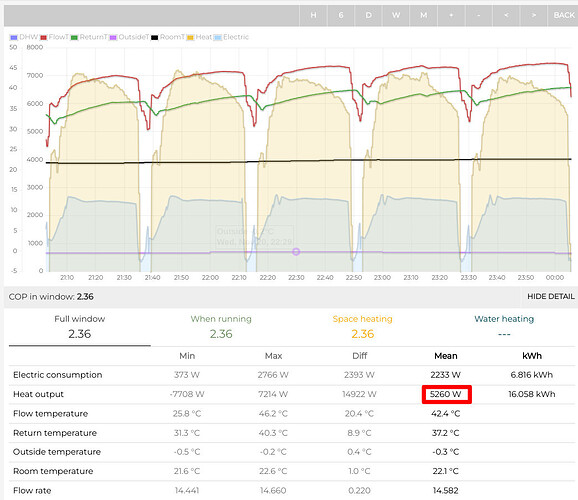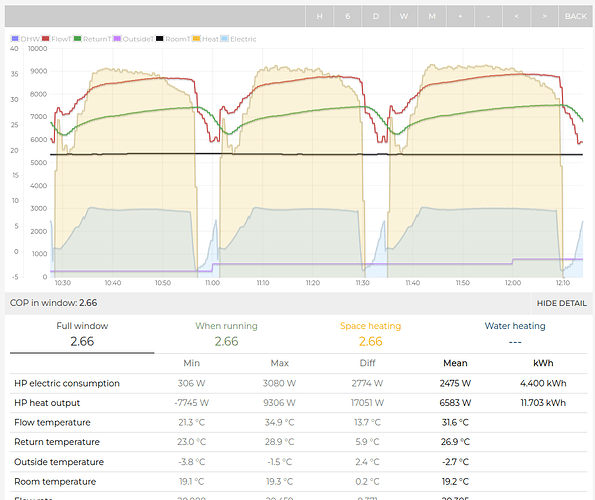@TrystanLea @UrbanPlumber What do you think is particular to the 7kW unit that makes it underperform? Undersized evaporator, poor compressor design?
A few to start with, variation between units is high.
One issue that may or may not be significant is that we are using MetOffice outside temperature data and while in general agreement is good, especially for longer term averages, looking at the precise outside conditions over x number defrosts some of the variation seen here could reflect deviations in the actual evaporator air in temperature. This is something we want to look at in more detail and perhaps provide the option for a direct outside temperature measurement at the back of the unit as standard.
These are all 7 kW Vaillant Arotherm’s (scroll to the right to see dashboard link):
| System ID | OutsideT | Peak FlowT | Mean FlowT | Flow rate | Peak elec | Mean elec | Peak output | Mean output | Datasheet | Missing W | Missing | Cycles | Dashboard link |
|---|---|---|---|---|---|---|---|---|---|---|---|---|---|
| 510 | -2.7 | 34.9 | 31.6 | 20.3 | 3080 | 2475 | 9306 | 6583 | 8800 | 2217 | 25% | 3 | Emoncms - app view |
| 510 | -3.2 | 35.1 | 31.9 | 20.3 | 3131 | 2451 | 9305 | 6385 | 8800 | 2415 | 27% | 3 | Emoncms - app view |
| 510 | -0.3 | 36.1 | 33.3 | 20.3 | 3224 | 2543 | 9636 | 6712 | 9500 | 2788 | 29% | 3 | Emoncms - app view |
| 124 | 0.1 | 34 | 31.9 | 24.6 | 2734 | 2099 | 11470 | 7727 | 9500 | 1773 | 19% | 4 | Emoncms - app view |
| 124 | -0.1 | 34.4 | 32.3 | 24.5 | 2980 | 2474 | 12442 | 8290 | 9500 | 1210 | 13% | 3 | Emoncms - app view |
| 282 | -2.8 | 37.4 | 35.7 | 20.3 | 3229 | 2778 | 10071 | 7391 | 8800 | 1409 | 16% | 4 | Emoncms - app view |
| n/a | -0.7 | 38.5 | 36 | 20.2 | 3033 | 2528 | 8600 | 5675 | 9200 | 3525 | 38% | 3 | Emoncms - app view |
| 284 | -2 | 39.2 | 36.5 | 20 | 3216 | 2589 | 8917 | 5936 | 8800 | 2864 | 33% | 4 | Emoncms - app view |
| 284 | -0.2 | 37.6 | 34.4 | 20.7 | 3148 | 2534 | 10249 | 6413 | 9400 | 2987 | 32% | 3 | Emoncms - app view |
| 315 | -0.9 | 47.9 | 43.9 | 20.2 | 3503 | 2939 | 8582 | 6239 | 9000 | 2761 | 31% | 5 | Emoncms - app view |
| 258 | 0 | 34.9 | 31.8 | 19.9 | 3166 | 2458 | 9556 | 6512 | 9500 | 2988 | 31% | 3 | Emoncms - app view |
| 517 | -3.2 | 46 | 43 | 20 | 3484 | 3054 | 8315 | 6925 | 9000 | 2075 | 23% | 2 | Emoncms - app view |
| 392 | -1.6 | 36.2 | 32.2 | 20.7 | 3087 | 2408 | 9461 | 6292 | 9100 | 2808 | 31% | 4 | Emoncms - app view |
One of the things we have to be careful with when taking max output measurements is that the unit is really trying to run at max output and that the compressor is not modulating down due to flow temps reaching near the WC flow target. E.g @glyn.hudson set his WC curve to target 90C flow temp at 0C outside to be sure it would try and go to max. Most of the systems here wont be specifically doing that extreme of a test but their compressor electrical consumption curves are very similar indicating that they are not quite meeting their curve target temperatures anyway.
E.g Glyn’s test, we see a characteristic shape here, there’s that peak electric consumption above 8 mins in, then a very slight reduction followed by a flattish period and then a slight curve downwards towards the end.
The same is visible in system id 124 example 1 Emoncms - app view. Are we therefore happy that this period reflects the maximum compressor output? We do see some variation in both the peak and mean electrical consumption for the above examples, some of this is variation in full cycle period length and length of the defrost period itself, providing slightly different duty cycles.
Will the 10kw still need planning approval with the upcoming changes to the rules?
If a property have a 7kw heatlose, why can’t the 10kw be left in low noise mode all the time? (Should also increase COP a little.)
If a property only needs 7kw, are primaries above 25mm truely needed?
I don’t see system volumn as an issue as volumizer are relatively cheap compared to vaillant installers and nearly all properties have space for a horizontal volumizer in the loft.
The 10kW minimum electrical power is around 1kW so you end up with a minimum heating power of around 4 kW at 0°C, higher when it’s warmer. You’d potentially see a lot more more cycling with the 10kW.
Over last few days, I been using some of the online price indicators from different large viallant installers.
- The most recent EPC was before upgrading loft insulation and having cavity wall insulation.
- We heat to a significant lower temperature the most people, so current heatlose is below any reasonble calculated.
- Recent peak gas use was little over 160kwh per day
- We used very little DHW on that day.
- None of them asked how much gas we use.
Yet over half the systems think the 7lw viallant is OK for us!
(It maybe they don’t understand a detected banaglow have higher heatlose then a detected two storey home with same floor area.)
True but oversized vaillants seem to do well. Is an oversized Vaillant a problem?
Yes it does well performancewise, but you can get room temperature fluctuations and badly timed DHW cycles can lead to quite long periods without any heating supplied. Whether the increased number of starts is problematic even if below the commonly given number of 4 starts/hour remains to be seen.
How hard would it be to read this from the variant online monitoring?
Interested to find out what we can do there, any pointers welcome.
I don’t see how without an ebus adapter.
Not looked at planning changes. Yes you can use 10kW with 7kW heat loss, main issue is min modulation is higher (so more cycling in should seasons), however, while not ideal Vaillant efficiency isn’t impacted that much by cycling.
Have to ask an installer about primary sizing; depends on length of primaries and also if ASHP pump is driving open-loop or just dropping into a bufffer. My primaries are 25mm, which is below what Vaillant recommends for 7kW but primaries are fairly short and I have a buffer. I’m pretty sure 10kW would be an issue with my (underground pre-insulated) primaries which can’t be upgraded. But, as i said my 7kW is oversized, so luckily not an issue.
Agree re: volume, but it might be a concern if trying to swtich out a 7kW for 10kW post-installation.
Or potentially Vailant API (same one the homeassistant plugin uses). This would require internet gateway though and some setup. This may only have outdoor sensor temp though, not compressor air inlet temp.
13 systems so far, average output ~6.7 kW, average datasheet suggested output 9.2 kW, average discrepancy 2.5 kW (27%).
11/13 systems seem to get 6.2 kW or more, but there is one that seems to be struggling around 5.5 kW and another around 5.9 kW.
In this test - is the defrost heat loss calculated in the HP heat output?
For intstance - HP meat output is 5260W. Defrost heat losses are for instance 0,7kWh. For a period ot 2 hours HP output will be 2*5260= 10520Wh. Considering defrost heat losses, the heat delivered will be 10520 - 700 = 9820Wh. Dividing this to 2 hours of work the mean HP output will be 4910W.
Yes it is included, heat output excluding loss to defrost is higher than the mean heat output figures given above ![]()
Is there any drop off in mean heat output from DHW or higher flow temperatures? Eg does removing DHW load gives more increase output for heating then the electricity used by an immersion heater?
hi all, i’m following this with interest. i’m a customer not an installer.
anyone had the exact same problem with the Ecodan?
i’ve got the 11.2 and i think my heat loss is pretty much that which means it struggled when the compressor is on max and it’s cold due to recurrent defrosts that zap the power of the unit, which kind of defeats the point of a heating system in my views. also, the noise of the compressor is no way what is quoted in the brochure.
Mitsubishi’s data book claims to be able to output over 11 kW, even through defrosts (grey line)
See 5kW R410a Ecodan PUHZ-W50VHA2(-BS) maximum output testing and ASHP sizing for Freezing Conditions
Sorry to ask a dumb question but one of the main thrusts of the thread is that the Vaillant ‘7kW’ units underperform, when averaged over defrost cycles, against their specs, but this seems to be substantiated based on an analysis of running results from OEM.
How do we know that the heat pumps analysed were being called to give their maximum output? If they weren’t then the output registered may not represent the maximum achievable. I think this question has already been asked upthread but I didn.t see it answered.
Yes, this is the assumption. In my case, I am certain that my unit was running at full capacity: the compressor was at 120 rps whenever not in defrost and the mean electrical power over the whole period was 2.7kW. In Trystan’s table, he has mean electrical output and these are all very high and he notes that the consumption curves are similar to the controlled tests and indicating not hitting heating curve target temp.


